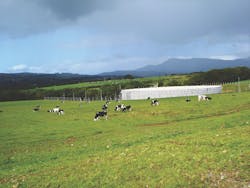Low-rate, Low-energy, High-quality
About the author: Shannon Grant is president of ADI Systems. Grant can be reached at [email protected].
Dairygold Co-operative Society Ltd. is Ireland’s leading farmer-owned dairy co-op business for cream, butter, cheese and whey production. Located in Mitchelstown, Cork County, Ireland, the plant produces several wastewater streams from various processing lines that must be properly treated before they can be safely discharged. Beyond sheer volume, dairy processing wastewater treatment is complicated by high concentrations of fats, oil and grease (FOG), biodegradable organics, whey, nutrients, and other complex or problematic compounds. These factors make dairy wastewater difficult to treat without appropriate technology.
Dairygold’s existing biological nutrient removal (BNR) system had high operating costs and energy requirements, and also was periodically overloaded. As the plant boosted milk processing capacity, it needed to upgrade and expand its wastewater treatment system to accommodate the increased flow. It also wanted to lower operating costs, if possible, and the plant needed the right treatment solution.
Treating Tricky Dairy Wastewater
Anaerobic digestion is proven to be an effective method for treating all kinds of dairy processing wastewater. In the absence of oxygen, the process uses microorganisms to break down organic waste and capture energy in the form of biogas. Aside from energy generation potential, anaerobic wastewater treatment systems also have low-energy requirements and sludge management costs. Compared to aerobic treatment, anaerobic digestion can reduce power consumption by 70% to 90% and produce approximately 90% fewer biosolids.
Anaerobic reactors range from high- to low-rate. High-rate reactors garner attention because of their high volumetric loading rate (VLR) and small footprint. However, high-rate reactor systems often encounter problems when treating dairy processing wastewater. This can include poor organic compound biological degradation, resulting in unsatisfactory wastewater treatment. High-rate anaerobic reactors also can have stability challenges due to biomass wash-out.
Low-Rate Technology, High-Quality Results
Low-rate anaerobic technology has numerous advantages for dairy processors over high-rate systems. The ADI-BVF reactor is an example of a low-rate, low-energy anaerobic system with simple and reliable operation.
The ADI-BVF system is designed with a lower VLR and more reactive volume than high-rate anaerobic treatment systems like up flow anaerobic sludge blankets. This extra volume allows the reactor to maintain a significant biomass inventory to better digest complex organic compounds, degradable waste solids, whey and FOG. The large reactor also reduces the total waste sludge volume and handling requirements, simplifying the overall treatment system. Moreover, unlike most high-rate reactor systems, the BVF reactor does not rely on the generation and retention of granular biomass to function effectively as it retains flocculent biomass.
Choosing the Right Treatment Technology
After evaluating several high-rate anaerobic options, Dairygold chose to partner with ADI Systems to integrate a low-rate anaerobic digestion system into its existing BNR system. The existing BNR system consisted of an equalization tank, dissolved air flotation (DAF) unit, aeration basin, anaerobic and anoxic tanks for biological phosphorus and nitrogen removal, and a clarifier. The new anaerobic reactor would pre-treat a combined wastewater flow of up to 2 million gal per day, greatly reducing organic load on the downstream BNR system.
Since milk production in Ireland is essentially grass-based, the wastewater flow and load trend at Dairygold’s plant follows seasonal milk production. The daily flow rapidly increases in the spring, exceeds the design capacity in the summer, decreases in autumn, and reduces to no flow conditions in winter due to an annual plant production shut down. During this time, minimal whey flow goes into the digester. The reactor typically restarts quickly in February when production resumes.
The operating temperature in the reactor is maintained between 79º and 86°F (26º to 30°C), with an average temperature of approximately 82°F (28°C). This is lower than the typical operating temperature for anaerobic digesters treating dairy processing wastewater, and saves energy for maintaining temperature. The operating temperature in the reactor runs even lower in winter when the plant shuts down.
The low-rate reactor pre-treats several combined wastewater streams, including powder line wastewater, a portion of the cheese line wastewater, and salty whey wastewater. The streams enter the reactor via a pipe network beneath the sludge bed. Wastewater then flows upward through the sludge bed, where microorganisms digest the feed and remove biochemical oxygen demand, chemical oxygen demand, and total suspended solids, while converting the majority of the organic load into energy-rich biogas.
Recovering Energy from Waste
The BVF reactor is completely sealed with a floating, insulated geomembrane cover. This allows the anaerobic digestion system to collect biogas with an average methane concentration of approximately 74%.
Collected biogas is used in a dual fuel boiler and as the primary energy source to produce hot water for maintaining the reactor’s operating temperature. Another heat exchanger is used to recover effluent heat and transfer it to the reactor influent, further lowering energy requirements. Any excess biogas is burnt in a flare.
The tank cover also controls temperature within the tank, minimizes offensive odors often associated with wastewater treatment, and prevents greenhouse gases from escaping into the atmosphere.
A ‘Whey’ Better Treatment System
The reactor consistently produces high-quality effluent, allowing Dairygold to remain compliant with strict environmental regulations. The system demonstrates reliable performance, averaging COD removals at greater than 92% (197 mg/L) and BOD removals of 97% (40 mg/L). The high organic removal reduces the load on the downstream BNR system, and improves the quality of the final effluent being discharged to a local stream.
The addition of the BVF reactor at Dairygold’s plant eliminated the need for DAF operation for solids and FOG removal, lowering operating costs. Moreover, the system allows Dairygold to use the biogas generated from the anaerobic digestion process as a source of green energy. It requires little maintenance and operator attention, yet effectively treats wastewater. The system at Dairygold demonstrates how effective the reactor is for dairy processing applications.
The system requires less energy and fewer chemicals, and produces fewer biosolids, while providing more process stability, more high-quality effluent, and ultimately a better economic return.
